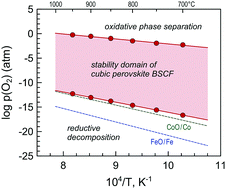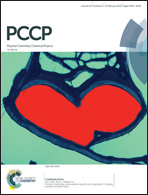The p(O2)–T stability domain of cubic perovskite Ba0.5Sr0.5Co0.8Fe0.2O3−δ†
Abstract
Cubic perovskite-type Ba0.5Sr0.5Co0.8Fe0.2O3−δ (BSCF) is one of the mixed ionic-electronic conductors with the highest oxygen permeability known to date. It serves as a parent material for the development of functional derivatives for electrochemical applications including oxygen separation membranes, solid electrolyte cell electrodes and electrocatalysts for the oxygen evolution reaction. The present study is focused on the determination of the precise stability boundaries of cubic perovskite BSCF employing a coulometric titration technique in combination with thermogravimetric analysis, X-ray and neutron diffraction, and molecular dynamics simulations. Both the low-p(O2) and high-p(O2) stability boundaries at 700–950 °C were found to correspond to a fixed value of oxygen content in the perovskite lattice of 3 − δ = ∼2.13 and ∼2.515, respectively. The stability limits in this temperature range are expressed by the following equations: high-p(O2) boundary: log p(O2) (atm) (±0.1) = −10 150/T (K) + 8.055; low-p(O2) boundary: log p(O2) (atm) (±0.03) = −20 750/T (K) + 4.681. The p(O2)–T phase diagram of the BSCF system under oxidizing conditions is addressed in a wider temperature range and is shown to include a region of precipitation of a “low-temperature” phase occurring at 400–500 °C. The fraction of the low-temperature precipitate, which co-exists with the cubic perovskite phase and is stable up to 790–820 °C, increases upon increasing p(O2) in the range 0.21–1.0 atm.



 Please wait while we load your content...
Please wait while we load your content...